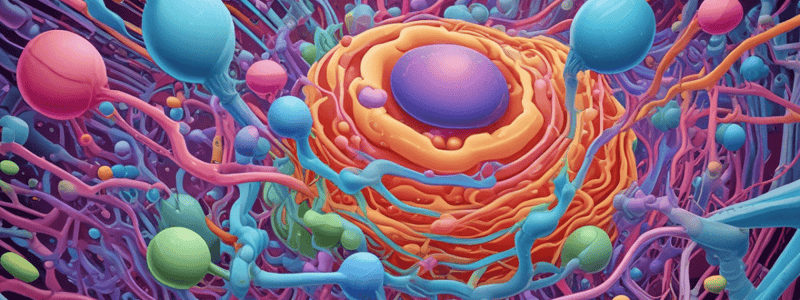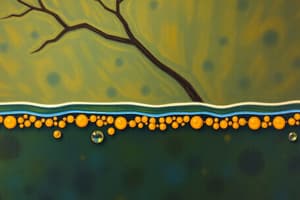Podcast
Questions and Answers
What is the primary function of the red blood cell membrane in microcirculation?
What is the primary function of the red blood cell membrane in microcirculation?
- To maintain constant shape regardless of external factors
- To be tough but flexible and show deformability (correct)
- To prevent all types of cellular interactions with plasma
- To store extra nutrients for the cell
What characteristic is enabled by the protein cytoskeleton interacting with the membrane lipid bilayer?
What characteristic is enabled by the protein cytoskeleton interacting with the membrane lipid bilayer?
- Deformability of the red blood cell membrane (correct)
- Permeability to large molecules
- Energy storage
- Rigidity of the red blood cell membrane
Which of the following is NOT a main function of the red blood cell membrane?
Which of the following is NOT a main function of the red blood cell membrane?
- Maintain characteristic shape
- Store genetic information (correct)
- Regulate intracellular cation concentrations
- Separate cell contents from plasma
What is the shape of erythrocytes?
What is the shape of erythrocytes?
Which lipid is NOT part of the 60% phospholipid composition of the red cell membrane?
Which lipid is NOT part of the 60% phospholipid composition of the red cell membrane?
Which integral protein facilitates anion transport across the red cell membrane?
Which integral protein facilitates anion transport across the red cell membrane?
Which component of the red cell membrane is characterized by polar head groups attached to non-polar fatty tails?
Which component of the red cell membrane is characterized by polar head groups attached to non-polar fatty tails?
What percentage of the red cell membrane's chemical structure is composed of carbohydrates?
What percentage of the red cell membrane's chemical structure is composed of carbohydrates?
Where do red blood cells develop?
Where do red blood cells develop?
What is the average lifespan of a red blood cell in the blood circulation?
What is the average lifespan of a red blood cell in the blood circulation?
Which protein facilitates glucose diffusion across the cell membrane?
Which protein facilitates glucose diffusion across the cell membrane?
What results from the phosphorylation of the Na+/K+ ATPase pump?
What results from the phosphorylation of the Na+/K+ ATPase pump?
Which disorder is characterized by the absence of Rh polypeptides and RhAG in the membrane?
Which disorder is characterized by the absence of Rh polypeptides and RhAG in the membrane?
What is the main function of ankyrin in the cytoskeleton?
What is the main function of ankyrin in the cytoskeleton?
What subunit binding pattern is associated with spectrin?
What subunit binding pattern is associated with spectrin?
What happens to glucose after it binds to GLUT-1 on the outside of the cell?
What happens to glucose after it binds to GLUT-1 on the outside of the cell?
Which protein directly binds to glycophorin A and C?
Which protein directly binds to glycophorin A and C?
Which primary membrane disorder results in the presence of a large proportion of oval or elliptical cells?
Which primary membrane disorder results in the presence of a large proportion of oval or elliptical cells?
What results from the dephosphorylation of the Na+/K+ ATPase pump?
What results from the dephosphorylation of the Na+/K+ ATPase pump?
Which of the following proteins is not part of the cytoskeleton's peripheral proteins?
Which of the following proteins is not part of the cytoskeleton's peripheral proteins?
Flashcards are hidden until you start studying
Study Notes
Integral Proteins
- Glycophorin A: a sialoglycoprotein that provides negative charge and acts as a binding site for viruses, bacteria, and parasites
- Glucose Transport Protein (GLUT 1): facilitates glucose diffusion across the membrane with 12 trans-membrane domains
- Band 3: facilitates anion transport across the membrane and has binding sites for Hb, ankyrin, Band 4.1, and Band 4.2
Representation of Membrane Structure
- Phospholipid Monolayer: a basic phospholipid bilayer that acts as a permeability barrier
- Spectrin Tetramer: a protein that forms a 2D lattice in the cytoskeleton
- Ankyrin Complex: a protein that anchors spectrin molecules to the lipid bilayer
- 4.1-R Complex: a protein that binds to spectrin close to the actin binding site
Pump
- Na+/K+ ATPase: an enzyme composed of 3 protein subunits that catalyzes the conversion of ATP to ADP to release energy
- Function of Na+/K+ ATPase: transports 3 Na+ molecules out of the cell and 2 K+ molecules into the cell, maintaining ion balance
Mechanism of Na+/K+ ATPase
- Phosphorylation: transports 3 Na+ molecules out of the cell
- Dephosphorylation: transports 2 K+ molecules into the cell
Primary Membrane Disorders
- Hereditary Spherocytosis: an autosomal inherited disorder that affects spectrin, causing spherocytosis and hemolytic anemia
- Hereditary Elliptocytosis: a disorder that causes elliptical red blood cells due to defective spectrin, Band 4.1, or Band 3
- Rh Null Syndrome: a disorder that causes the absence of Rh polypeptides and RhAG in the membrane, leading to stomatocytosis and spherocytosis
Red Cell Membrane
- Functions: separates cell contents from plasma, maintains shape, regulates intracellular cation concentrations, and is a site for membrane surface receptors
- Composition: 44% lipid, 49% protein, and 7% carbohydrate
- Glycocalyx: an outer carbohydrate "coat" made up of extracellular proteins and glycosylated proteins and lipids from the lipid bilayer
Studying That Suits You
Use AI to generate personalized quizzes and flashcards to suit your learning preferences.



